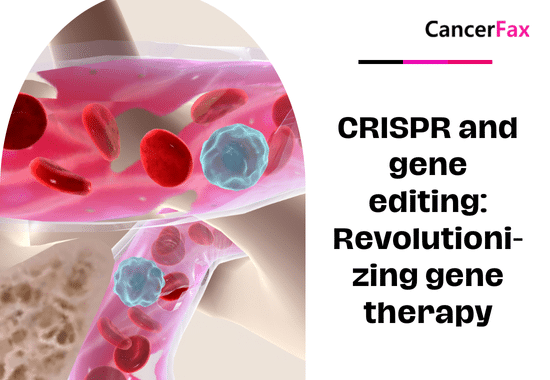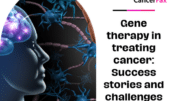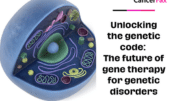CRISPR and gene editing: Revolutionizing gene therapy
Evolution of CRISPR-Cas9
The CRISPR-Cas9 gene-editing tool has changed gene therapy into a means that is more precise, efficient, and versatile when editing genetic code. A technology of this sophistication gives immense scope for treating a wide array of genetic disorders, cancers, and even other diseases, by allowing scientists to modify DNA sequences directly within living organisms.
The paper takes into consideration the principles of CRISPR-Cas9, gene therapy applications, success stories, challenges, and ethical concerns associated with its application.
Understanding CRISPR Cas-9
Basically, this is Clustered Regularly Interspaced Short Palindromic Repeats, which is the natural defense mechanism used by bacteria. Through the CRISPR system, along with the Cas9 enzyme, the bacteria trace the origin and cut foreign DNA within invading viruses.
In 2012, Jennifer Doudna and Emmanuelle Charpentier first demonstrated that the system—including CRISPR-Cas9—can precisely edit genomes in higher organisms, such as humans.
The system works by:
- Guide RNA (gRNA): A custom-designed RNA molecule that matches the target DNA sequence.
- Cas9 Enzyme: An endonuclease that creates a double-strand break at the target site.
- DNA Repair: The cell’s natural repair mechanisms either introduce mutations (non-homologous end joining) or insert new genetic material (homology-directed repair).
Applications in Gene Therapy
- Correcting Genetic Mutations:
- CRISPR-Cas9 can correct disease-causing mutations at their source. For example, researchers have used CRISPR to correct the mutation responsible for cystic fibrosis in human cells.
- Targeting Cancer Cells:
- CRISPR can be employed to target and disrupt oncogenes or enhance the immune system’s ability to recognize and destroy cancer cells. For instance, CRISPR-edited T cells have been used to target and kill cancer cells more effectively.
- Eradicating Viral Infections:
- CRISPR technology holds promise for eliminating viral DNA from infected cells. Research is underway to use CRISPR to target and remove the HIV genome from human cells, offering a potential cure for the virus.
- Enhancing Drug Resistance:
- CRISPR can be used to create models of drug-resistant cancers, allowing researchers to study the mechanisms of resistance and develop more effective treatments.

Pic: CRISPR and gene editing Revolutionizing gene therapy
Success Stories
- Sickle Cell Disease:
- In 2019, a patient with sickle cell disease received CRISPR-based gene therapy to correct the defective gene responsible for the disorder. Early results showed a significant reduction in disease symptoms, marking a milestone in gene therapy.
- Beta-Thalassemia:
- A similar approach has been used to treat beta-thalassemia, a genetic blood disorder. Patients receiving CRISPR-edited cells have shown promising outcomes, with a reduced need for blood transfusions.
- Hereditary Blindness:
- Researchers have used CRISPR to correct mutations causing Leber congenital amaurosis, a form of inherited blindness. Clinical trials are ongoing, but early results indicate potential restoration of vision.
Challenges and Ethical Considerations
- Off-Target Effects:
- Despite its precision, CRISPR can sometimes cause unintended mutations at off-target sites. Ensuring the accuracy and safety of gene editing remains a critical challenge.
- Delivery Methods:
- Efficiently delivering CRISPR components to target cells in vivo is complex. Researchers are exploring various delivery methods, including viral vectors and nanoparticles, to improve efficiency and specificity.
- Ethical Concerns:
- The ability to edit human genes raises profound ethical questions, particularly concerning germline editing, which can pass changes to future generations. The potential for “designer babies” and the implications of genetic enhancements are hotly debated.
- Regulatory Hurdles:
- Developing regulatory frameworks to oversee the safe and ethical use of CRISPR is essential. Balancing innovation with safety and ethical considerations is a critical task for policymakers.
The Future of CRISPR and Gene Therapy
The potential of CRISPR-Cas9 extends beyond treating genetic disorders. Future applications may include:
- Agricultural Enhancements:
- CRISPR can be used to create crops with improved yields, disease resistance, and nutritional value, addressing global food security challenges.
- Environmental Applications:
- Gene editing could help in the conservation of endangered species or the control of invasive species, contributing to biodiversity preservation.
- Advanced Biomedical Research:
- CRISPR-based tools are accelerating biomedical research, enabling scientists to create more accurate models of human diseases and develop new therapies.
Conclusion
CRISPR-Cas9 has been the magic bullet of gene therapy for genetic disorders, cancers, and viral infections. It has been an unprecedentedly useful tool along the avenue toward the cure of untreatable illnesses that, to this day, defy cure.
Its meteoric rise into mainstream discourse also brings along with it some serious complications and dire ethical dilemmas. Under conditions of safety, fairness, and ethics, ensuring that research is carried out will be hugely important as this technology continues to unfold in an effort to change the future face of medicine.
References:
- CRISPR-Cas9 Mechanism:
- Jinek, M., Chylinski, K., Fonfara, I., Hauer, M., Doudna, J.A., & Charpentier, E. (2012). A programmable dual-RNA-guided DNA endonuclease in adaptive bacterial immunity. Science, 337(6096), 816-821. doi:10.1126/science.1225829.
- Precision and Efficiency:
- Doudna, J.A., & Charpentier, E. (2014). The new frontier of genome engineering with CRISPR-Cas9. Science, 346(6213), 1258096. doi:10.1126/science.1258096.
- Versatility:
- Cong, L., Ran, F.A., Cox, D., Lin, S., Barretto, R., Habib, N., … & Zhang, F. (2013). Multiplex genome engineering using CRISPR/Cas systems. Science, 339(6121), 819-823. doi:10.1126/science.1231143.
- Cost-Effectiveness:
- Sander, J.D., & Joung, J.K. (2014). CRISPR-Cas systems for editing, regulating and targeting genomes. Nature Biotechnology, 32(4), 347-355. doi:10.1038/nbt.2842.
- Sickle Cell Anemia and Beta-Thalassemia:
- Frangoul, H., Altshuler, D., Cappellini, M.D., Chen, Y., Domm, J., Eustace, B.K., … & Walters, M.C. (2021). CRISPR-Cas9 gene editing for sickle cell disease and β-thalassemia. New England Journal of Medicine, 384(3), 252-260. doi:10.1056/NEJMoa2031054.
- Hereditary Blindness:
- Maeder, M.L., Linder, S.J., Cascio, V.M., Fu, Y., Ho, Q.H., Parikh, V.S., … & Joung, J.K. (2013). CRISPR RNA–guided activation of endogenous human genes. Nature Methods, 10(10), 977-979. doi:10.1038/nmeth.2598.
- Cancer Immunotherapy:
- Stadtmauer, E.A., Fraietta, J.A., Davis, M.M., Cohen, A.D., Weber, K.L., Lancaster, E., … & June, C.H. (2020). CRISPR-engineered T cells in patients with refractory cancer. Science, 367(6481), eaba7365. doi:10.1126/science.aba7365.
- Off-Target Effects:
- Tsai, S.Q., & Joung, J.K. (2016). Defining and improving the genome-wide specificities of CRISPR-Cas9 nucleases. Nature Reviews Genetics, 17(5), 300-312. doi:10.1038/nrg.2016.28.
- Delivery Methods:
- Yin, H., Kauffman, K.J., & Anderson, D.G. (2017). Delivery technologies for genome editing. Nature Reviews Drug Discovery, 16(6), 387-399. doi:10.1038/nrd.2016.280.
- Ethical Concerns:
- Lanphier, E., Urnov, F., Haecker, S.E., Werner, M., & Smolenski, J. (2015). Don’t edit the human germ line. Nature, 519(7544), 410-411. doi:10.1038/519410a.
- Base Editing and Prime Editing:
- Anzalone, A.V., Randolph, P.B., Davis, J.R., Sousa, A.A., Koblan, L.W., Levy, J.M., … & Liu, D.R. (2019). Search-and-replace genome editing without double-strand breaks or donor DNA. Nature, 576(7785), 149-157. doi:10.1038/s41586-019-1711-4.
These references provide a robust foundation for the discussion on how CRISPR and gene editing are revolutionizing gene therapy.
Susan Hau is a distinguished researcher in the field of cancer cell therapy, with a particular focus on T cell-based approaches and cancer vaccines. Her work spans several innovative treatment modalities, including CAR T-cell therapy, TIL (Tumor-Infiltrating Lymphocyte) therapy, and NK (Natural Killer) cell therapy.
Hau's expertise lies in cancer cell biology, where she has made significant contributions to understanding the complex interactions between immune cells and tumors.
Her research aims to enhance the efficacy of immunotherapies by manipulating the tumor microenvironment and exploring novel ways to activate and direct immune responses against cancer cells.
Throughout her career, Hau has collaborated with leading professors and researchers in the field of cancer treatment, both in the United States and China.
These international experiences have broadened her perspective and contributed to her innovative approach to cancer therapy development.
Hau's work is particularly focused on addressing the challenges of treating advanced and metastatic cancers. She has been involved in clinical trials evaluating the safety and efficacy of various immunotherapy approaches, including the promising Gamma Delta T cell therapy.
- Comments Closed
- July 17th, 2024






CRISPR clinical trials, CRISPR gene editing, CRISPR-Cas9 technology, Future of genetic medicine, Gene editing applications, Gene therapy revolution, Genetic engineering breakthroughs, Precision medicine advances
🌟 Welcome to Beijing Biotech! 🌟
Thank you for reaching out! We are dedicated to transforming lives through advanced gene therapy solutions for sickle cell disease and thalassemia. Our team is committed to delivering cutting-edge treatments, personalized care, and support on every step of your journey to better health.
Please feel free to ask any questions or let us know how we can assist you. Together, we’re here to make a difference.
Warm regards,
The Beijing Biotech Team